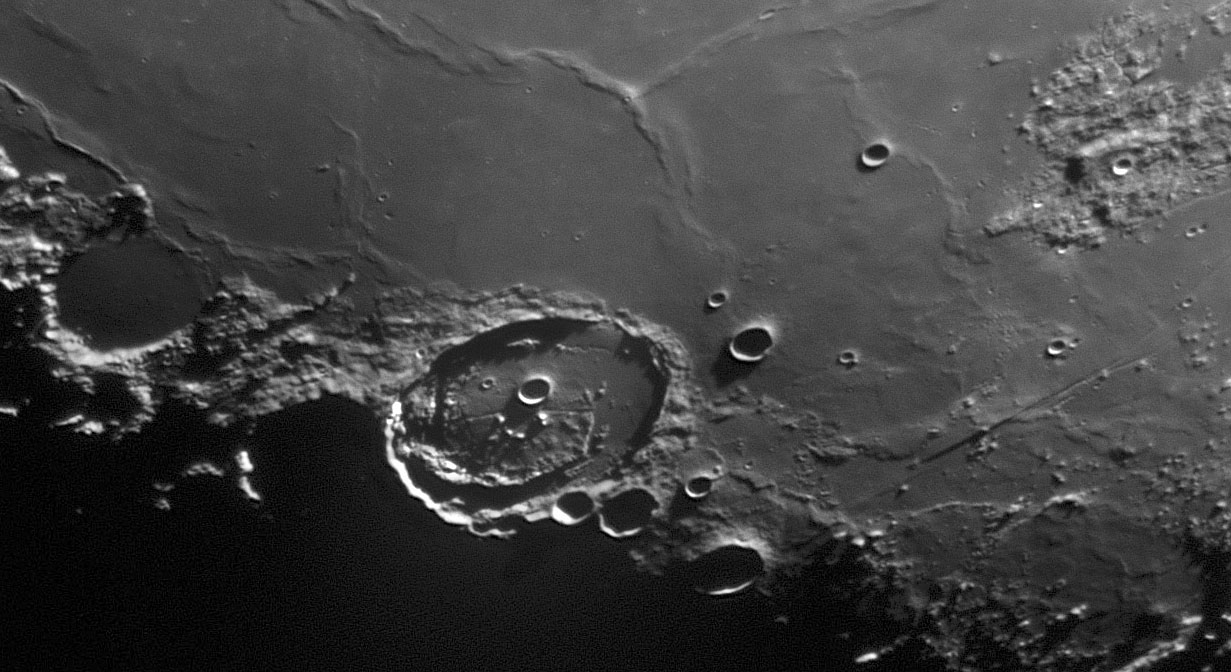Difference between revisions of "February 6, 2010"
| Line 1: | Line 1: | ||
__NOTOC__ | __NOTOC__ | ||
=Not the Center of Attention= | =Not the Center of Attention= | ||
| − | |||
<!-- ws:start:WikiTextHeadingRule:1:<h1> --> | <!-- ws:start:WikiTextHeadingRule:1:<h1> --> | ||
<!-- ws:start:WikiTextLocalImageRule:16:<img src="/file/view/LPOD-Feb6-10.jpg/118487867/LPOD-Feb6-10.jpg" alt="" title="" /> -->[[File:LPOD-Feb6-10.jpg|LPOD-Feb6-10.jpg]]<!-- ws:end:WikiTextLocalImageRule:16 --><br /> | <!-- ws:start:WikiTextLocalImageRule:16:<img src="/file/view/LPOD-Feb6-10.jpg/118487867/LPOD-Feb6-10.jpg" alt="" title="" /> -->[[File:LPOD-Feb6-10.jpg|LPOD-Feb6-10.jpg]]<!-- ws:end:WikiTextLocalImageRule:16 --><br /> | ||
| Line 8: | Line 7: | ||
Posidonius grabs attention with its familiar tilted floor and a gap in the rim where lavas must have once flowed down onto Mare Serenitatis. But in the background are rilles and ridges that have stories to tell. The edge of the Serpentine Ridge at top center is connected to other ridges that define an oval larger than Posidonius. Does the oval ridge mark a older crater, flooded by mare lavas? I don't think so. Notice that Posidonius and nearby craters are elongated roughly left to right, with a little tilt upward on the right. That is the direction of foreshortening, paralleling the nearest limb. The mare ridge oval is not elongated in the same direction so it is not a circular object, and thus probably not a buried crater. Compare with the similar ridge oval south of Plato, which has the proper orientation to be circular if the foreshortening is corrected. Now look at the linear rilles along the right edge of the image. The most conspicuous one just south (right) of Posidonius - Daniell Rille - is remarkable because it casts a shadow along part of its length, indicating one side is higher than the other, as happens when vertical faulting has occurred. Above (west) of Daniell are other narrower rilles almost trending in the same direction.<br /> | Posidonius grabs attention with its familiar tilted floor and a gap in the rim where lavas must have once flowed down onto Mare Serenitatis. But in the background are rilles and ridges that have stories to tell. The edge of the Serpentine Ridge at top center is connected to other ridges that define an oval larger than Posidonius. Does the oval ridge mark a older crater, flooded by mare lavas? I don't think so. Notice that Posidonius and nearby craters are elongated roughly left to right, with a little tilt upward on the right. That is the direction of foreshortening, paralleling the nearest limb. The mare ridge oval is not elongated in the same direction so it is not a circular object, and thus probably not a buried crater. Compare with the similar ridge oval south of Plato, which has the proper orientation to be circular if the foreshortening is corrected. Now look at the linear rilles along the right edge of the image. The most conspicuous one just south (right) of Posidonius - Daniell Rille - is remarkable because it casts a shadow along part of its length, indicating one side is higher than the other, as happens when vertical faulting has occurred. Above (west) of Daniell are other narrower rilles almost trending in the same direction.<br /> | ||
<br /> | <br /> | ||
| − | <em>[mailto:tychocrater@yahoo.com Chuck Wood]</em><br /> | + | <em>[mailto:tychocrater@yahoo.com" rel="nofollow Chuck Wood]</em><br /> |
<br /> | <br /> | ||
<strong>Technical Details</strong><br /> | <strong>Technical Details</strong><br /> | ||
| Line 17: | Line 16: | ||
<br /> | <br /> | ||
<hr /> | <hr /> | ||
| − | <div>You can support LPOD when you buy any book from Amazon thru [http://www.lpod.org/?page_id=591 LPOD!]<br /> | + | <div>You can support LPOD when you buy any book from Amazon thru [http://www.lpod.org/?page_id=591" rel="nofollow LPOD!]<br /> |
</div> | </div> | ||
| − | |||
---- | ---- | ||
===COMMENTS?=== | ===COMMENTS?=== | ||
Click on this icon [[image:PostIcon.jpg]] at the upper right to post a comment. | Click on this icon [[image:PostIcon.jpg]] at the upper right to post a comment. | ||
Revision as of 19:19, 4 January 2015
Not the Center of Attention

image by [[1]]
Posidonius grabs attention with its familiar tilted floor and a gap in the rim where lavas must have once flowed down onto Mare Serenitatis. But in the background are rilles and ridges that have stories to tell. The edge of the Serpentine Ridge at top center is connected to other ridges that define an oval larger than Posidonius. Does the oval ridge mark a older crater, flooded by mare lavas? I don't think so. Notice that Posidonius and nearby craters are elongated roughly left to right, with a little tilt upward on the right. That is the direction of foreshortening, paralleling the nearest limb. The mare ridge oval is not elongated in the same direction so it is not a circular object, and thus probably not a buried crater. Compare with the similar ridge oval south of Plato, which has the proper orientation to be circular if the foreshortening is corrected. Now look at the linear rilles along the right edge of the image. The most conspicuous one just south (right) of Posidonius - Daniell Rille - is remarkable because it casts a shadow along part of its length, indicating one side is higher than the other, as happens when vertical faulting has occurred. Above (west) of Daniell are other narrower rilles almost trending in the same direction.
" rel="nofollow Chuck Wood
Technical Details
The XXXX in the "image by" line under the photo indicates that this is another image that I have separated from its owner's name! Please help me give credit to whoever acquired this excellent image!
Related Links
Rükl plate 14
COMMENTS?
Click on this icon File:PostIcon.jpg at the upper right to post a comment.



